Co-author: Harald Svendsen, SINTEF

Harnessing the potential of offshore wind will require large investments in an offshore grid. Optimising this system can lead to huge savings.
The need for an ocean grid
There is a growing consensus that offshore renewable energy is going to be vital for the transition towards a carbon-neutral European energy system. The main reasons for that are better wind resources offshore and space limitations on land. The North Sea in particular has a high wind energy potential, and offers a great opportunity for neighbouring countries, including Norway. This potential was formally recognised when the recently signed “Ostend Declaration” characterised the North Sea as the “green power plant of Europe”.
To capture offshore wind energy and exploit this enormous potential, it is not only necessary to develop large-scale wind farms but also the associated infrastructure to transfer the energy from the production point to the mainland connection point, from where it will be further distributed to consumers. Such developments necessitate substantial capital investments, primarily due to the inherent difficulty of building such technical infrastructure in remote maritime environments, and secondarily due to the use of technologically advanced and expensive equipment. Offshore wind farms and offshore electricity infrastructure require extensive planning, often spanning several years, and are projected to be built in a step-by-step manner over the coming years and decades. Meanwhile, the energy system to which the wind farms are connected is also changing. As more renewables are integrated into the system and new technologies are becoming more widely adopted (electric vehicles and hydrogen, for instance), the energy system will progressively become more flexible, and the power generation mix will be composed of higher shares of intermittent resources.
The Ocean Grid project addresses the question of how the offshore electricity grid can be developed in a step-by-step fashion to give the most profitable integration of large offshore wind power for developers and society as a whole. Key issues considered are the changing energy system, high costs of the grid infrastructure, long planning times, and long lifetime once installed. Considering uncertainties and balancing present and future benefits and costs are essential to realise a stepwise grid development that is close to optimal. The horizon specified for the stage-wise optimal grid development, which is aligned with the European ambitions, spans from 2035 to 2050.
The benefits of an interconnected ocean grid
Even if all necessary infrastructure is built to fully exploit the offshore wind potential in the North Sea, there is a critical limiting factor for the degree to which offshore wind can be integrated into the energy system: energy is not used if not needed. On top of that, if we could replace parts of expensive and emission-intensive power generation with abundant clean energy, the generation cost of the energy-demanding location would decrease. This is only possible if we allow for more pathways for electricity to flow and if we can transfer electricity produced from a specific offshore location to be consumed to a different demand location. Since this is not possible with conventional point-to-point connections, an interconnected, international grid should be developed, connecting the offshore wind farms and providing an interface for the electricity markets of the various countries involved, to further reduce power generation costs. As has been demonstrated by previous studies, sharing electricity transmission infrastructure can lead to lower overall electricity costs. In other words, by interconnecting the offshore wind farms to be developed around the North Sea, several participants could benefit at the same time while increasing the usability of wind resources, being naturally intermittent (i.e., if the wind doesn’t blow in the UK why shouldn’t we still be able to use the “North Sea power plant” and use the excess wind produced in Norway instead?)
From society’s point of view, achieving an interconnected grid can be beneficial. However, it’s not just any grid that we are aiming for. We need an optimal grid development where costs and benefits are balanced, while uncertainties about the future are also considered, leading to economically robust investment choices. In addition, to answer the question of which are the best interconnections that should be built “now”, one must also consider that the operation of the system in the future depends on past decisions. The question is equivalent to what the best possible grid layout should be, assuming some future offshore wind farm development plans and decisions that have already been taken. What we are looking for is therefore an optimal sequence of investment decisions throughout the planning horizon (2035-2050), and which should balance the total investment costs with the expected cost savings from the future system operation. To answer such questions, research activities in Ocean Grid work package 1 “Offshore grid development” aim to find the optimal investment decisions by formulating and solving proper Mathematical Optimisation problems.
Optimising the future ocean grid: a tough assignment
The associated optimisation problems for the development of optimal interconnected (meshed) grids, which are formulated as Mixed-Integer Linear Programs (MILP), typically involve intensive computations and are notorious for the extreme amount of time they take to be computed. It may even be the case that solving such a problem is not possible at all, in a reasonable amount of time, even using the best existing supercomputer. This complexity arises because each integer variable significantly increases the number of potential combinations the program must explore to find the best solution, much like adding extra dimensions to a maze makes it far more challenging to navigate.
To account for the time required for the construction of the new interconnections, the formulations employed include several stages where we should make decisions, for example, assuming that new interconnections can be decided only in 2035, 2040 and 2050, we end up with a multi-stage MILP formulation. In addition to that, spreading the grid buildout is a way to accommodate various uncertain factors that may be revealed at a later stage. For example, at present we can only assume how the energy mix or the demand in Norway and other countries will be in 2040, but from that point on, the energy mix/demand is known information that could be used by the decision maker. To include this logic in the formulation, several possible future scenarios are being constructed, where the uncertain parameters take different values and can be realised with different probabilities. This results in a Stochastic Optimisation problem, which dramatically increases the dimensionality of the original multi-stage MILP formulation, paving the way for computationally efficient solutions methods to be found.
MILP explained: A road network analogy
Imagine that you are living in a country with many cities but not enough roads connecting these cities. If people want to travel from one city to another, there should be a road connecting them. A construction company is assigned to the task of building the smallest number of roads, with the correct size, such that people can move from any given city to any other one. However, the amount of people in each city will soon change, since a large number of immigrants is expected. In addition, roads cannot be built absolutely everywhere because of restrictions due to the natural landscape. Similarly, the size of a road is dependent on the available space, which in turn depends on the local topography. The construction company has to take all these factors into account and start building a road network that will be gradually expanded in the future, based on its best estimates about the number of people arriving in the country. Roads have to be large enough to avoid congestion or the need to add more lanes in the future. In addition, since building roads is expensive, the construction company has to evaluate if certain pathways can be strategically omitted, allowing people to use existing “major” roads from neighbouring cities instead.
A first glimpse of what the future Ocean Grid may look like
As an illustrative example, we present some initial results on what a potential future ocean grid could be, under some specific assumptions. Those include:
- offshore wind farms build-out plans based on openly available reports and speculations (i.e., The Norwegian Energy and Water Directorate, NVE, in Norway),
- the future development of associated countries’ energy systems, based on the ENTSOE-E TYNDP 2022 – Distributed Energy storyline (as well as some case-specific assumptions from grid operators about Norway – Statnett),
- potential interconnections that are not only mathematically meaningful but also deemed realistic from an industry perspective,
- and finally, some cost assumptions about the associated HVDC links to realise those interconnections, based on an overview of existing projects and published economic data.
The planning starts with an initial condition, assuming some existing interconnections as illustrated in the first figure below, where the purple lines represent the existing, offshore (and onshore for Norway) interconnections in 2030, while the yellow lines represent a simplified existing onshore grid. Then, in the second figure, the possible candidate interconnections are presented in purple, clearly indicating the increased number of choices and the corresponding complexity of the problem. This “spaghetti of interconnections” does not mean that all those branches will be selected but, instead, it reveals what the potential branches are, from which some will be selected when using the optimisation algorithm.
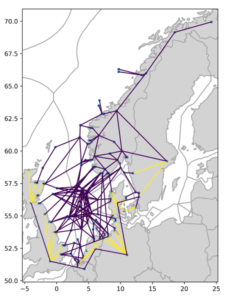
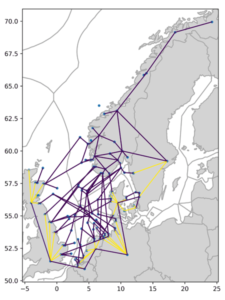
Next, the mathematical optimisation problem is formulated and solved to get the optimal investments per decision period. This case is a work in progress, where we have so far implemented the above scenario in a deterministic version and considered a single set of assumptions at a time. The optimisation problem is formulated based on the in-house, open-source PowerGIM code, and solved with the commercial solver Gurobi. The stage-wise example results for one out of several model runs are presented in the three figures below for each decision period, 2035, 2040, and 2050, correspondingly.

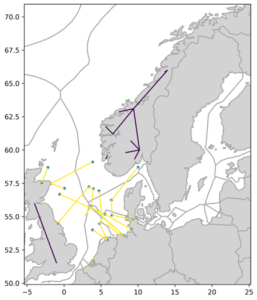
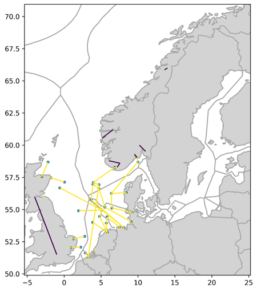
The new offshore interconnections that are decided optimally, to expand the existing offshore grid, are presented in yellow lines. Those are derived from all the possible candidate interconnections illustrated in the “spaghetti” figure and represent the most beneficial selections of lines to be built, per stage, for this example case. These figures show that grid development will be happening throughout all decision periods. This means that if some interconnections are delayed instead of being built as soon as possible, cost savings can be achieved, leading to better investment decisions (lower total investment cost). However, the most urgent decision that concerns the ocean grid development is the one from the first investment period (2035), the first stage in the two-stage optimisation problem, which defines the interconnections plan that will need to be built first, as illustrated in the figure below (purple lines), for this simplified, example case study.
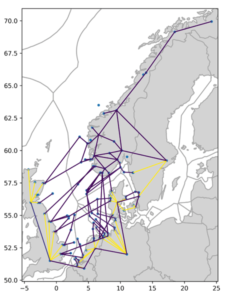
What’s next?
As we have seen so far, the problems that need to be solved for deciding the optimal future ocean grid layout can be very complex, even if we disregard the different uncertainty factors (as we did in the example above). The next step is to include such uncertainties in the problem and find an optimal investment plan, irrespective of the uncertainty realisations in the future. In other words, the quest is to discover the required ocean grid developments in the first investment period (2035), so that the total costs, when including the investments of the following periods, remain as low as possible, even if future events take us on an unexpected path. However, such an approach heavily impacts the computational efficiency of the corresponding optimisation problem, and can lead to cases where even finding the solution becomes impossible (aka the problem becomes intractable). For that reason, advanced optimisation methods are currently being developed, to better exploit some properties and structures of the underlying mathematical formulations and allow for a “divide-and-conquer” strategy which may improve the computational efficiency and make it possible to find solutions for even more complex cases of the ocean grid problem.

0 comments on “The quest for a cost-efficient offshore grid”